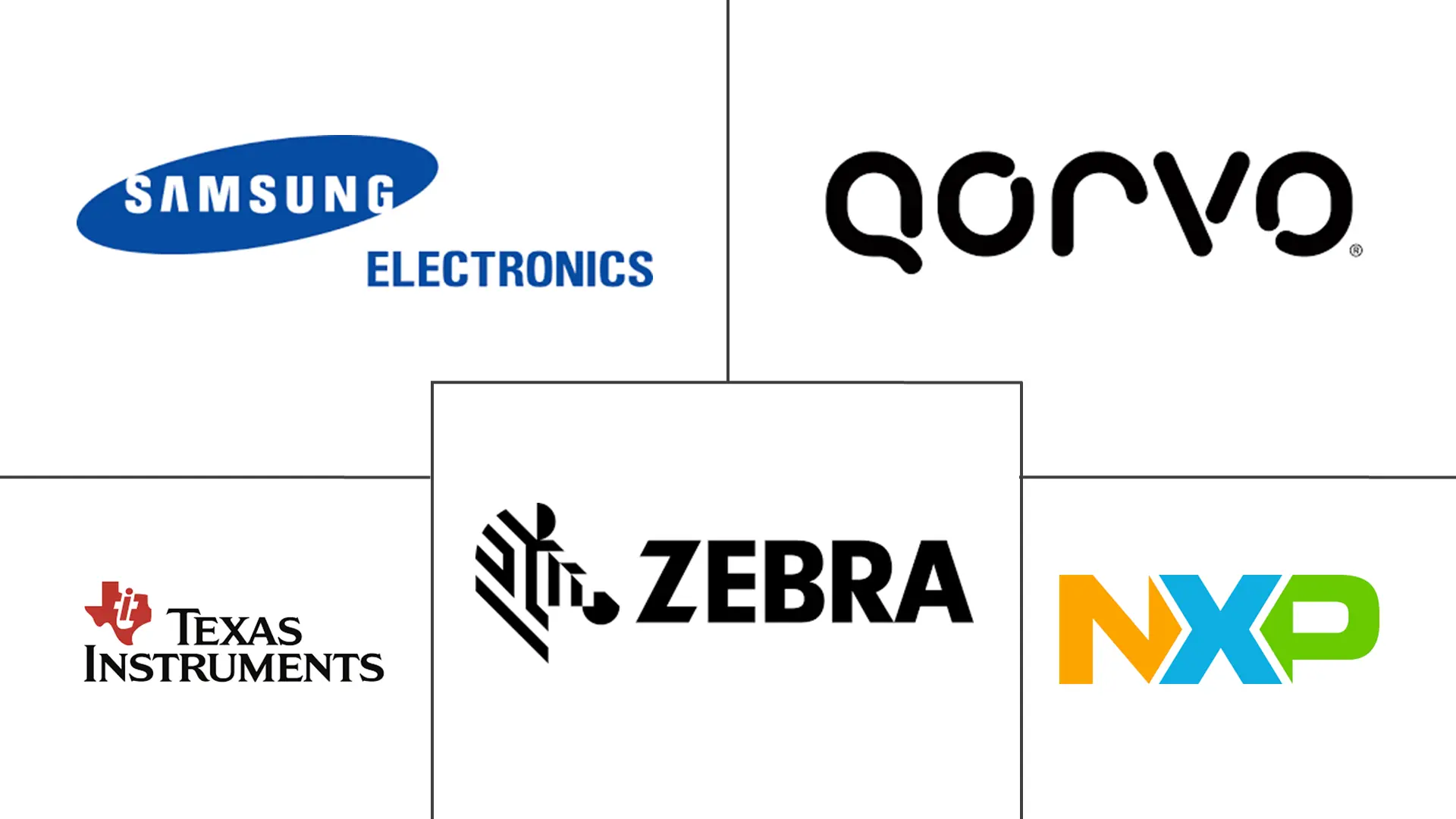Ultra Wideband Market Size and Share
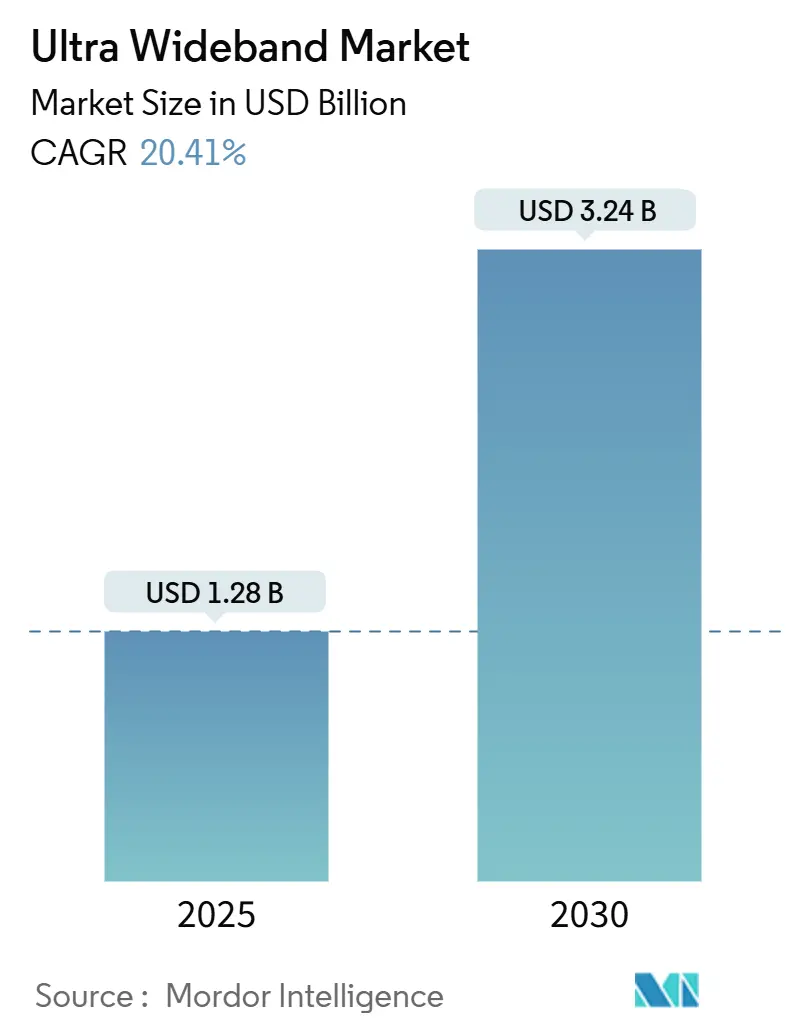
Ultra Wideband Market Analysis by Mordor Intelligence
The Ultra Wideband Market size is estimated at USD 1.28 billion in 2025, and is expected to reach USD 3.24 billion by 2030, at a CAGR of 20.41% during the forecast period (2025-2030). Centimeter-level accuracy, low latency, and strong multipath immunity position UWB as the first-choice technology for real-time location services in smart factories, connected vehicles, and premium smartphones. Rising deployment of Industry 4.0 plants, regulatory clarity on 6-10.6 GHz operations, and integration of digital keys in next-generation automobiles collectively underpin sustained double-digit expansion. Component suppliers pursue single-chip Wi-Fi-Bluetooth-UWB platforms to reduce bill-of-material costs, while software vendors embed AI-based ranging algorithms to boost accuracy and cut power drain. Strategic design wins with automotive OEMs and handset leaders validate the technology’s mass-market readiness and create scale economies that drive unit pricing down.
Key Report Takeaways
- By component, ICs/Chipsets held 41.23% Ultra Wideband market share in 2024, while Software is projected to grow at a 22.15% CAGR through 2030.
- By end-user vertical, consumer electronics accounted for 36.45% of the Ultra Wideband market size in 2024, whereas automotive and transportation are forecast to expand at a 23.02% CAGR to 2030.
- By device type, smartphones captured 38.67% revenue share in 2024, and drones and robots led growth with a 24.26% CAGR to 2030.
- By frequency band, the 6-10.6 GHz segment generated 54.12% of 2024 sales, but the 3.1-4.8 GHz band is set to rise at 21.68% CAGR over the same horizon.
- By range capability, short-range (<10 m) installations commanded 62.34% share of the Ultra Wideband market size in 2024; long-range (>30 m) applications advance the fastest at 22.73% CAGR.
- By geography, North America led with 42.10% Ultra Wideband market share in 2024, while Asia Pacific records the highest regional CAGR at 21.61% through 2030.
Global Ultra Wideband Market Trends and Insights
Drivers Impact Analysis
| Driver | (~) % Impact on CAGR Forecast | Geographic Relevance | Impact Timeline |
|---|---|---|---|
| Explosive RTLS demand across Industry 4.0 plants | +4.2% | Global, with concentration in Germany, US, China manufacturing hubs | Medium term (2-4 years) |
| Smartphone OEM mandate for spatial-awareness features | +3.8% | Global, led by North America and Asia Pacific premium segments | Short term (≤ 2 years) |
| Regulatory green-lights for sub-GHz UWB in Europe and Asia Pacific | +2.9% | Europe and Asia Pacific, spillover to emerging markets | Long term (≥ 4 years) |
| Automotive shift to digital keys and in-cabin radar | +3.5% | North America, Europe, with Asia Pacific adoption acceleration | Medium term (2-4 years) |
| Millimeter-level accuracy enabling AR/VR spatial mapping | +2.7% | North America and Asia Pacific technology centers | Long term (≥ 4 years) |
| Defense need for GPS-denied troop tracking | +1.8% | North America, Europe, with selective Asia Pacific markets | Long term (≥ 4 years) |
| Source: Mordor Intelligence | |||
Explosive RTLS demand across Industry 4.0 plants
Manufacturers roll out real-time location systems to track assets, work-in-progress, and personnel with sub-meter precision. Siemens reported a 30% cut in asset search time and a 15% reduction in unnecessary equipment purchases after implementing UWB-based RTLS at multiple plants [1]Harald Krüger, “SIMATIC RTLS Productivity Gains,” siemens.com. UWB’s ability to maintain accuracy despite metallic obstructions and RF noise gives it an edge over Wi-Fi and BLE. Volkswagen Slovakia leveraged Qorvo tags to raise assembly-line efficiency, evidencing payback across high-volume production environments. Predictable ROI propels mid-sized factories to scale deployments, expanding addressable demand beyond early adopters.
Smartphone OEM mandate for spatial-awareness features
Apple’s U1 and U2 chips on iPhones and Apple Watch catalyzed a race among Android players to match precision-finding experiences. Samsung’s Exynos Connect U100, launched in July 2024, achieves centimeter-grade ranging with sub-10 ns timestamping to support secure file-sharing, tag-to-device discovery, and AR gaming [2]Samsung Electronics, “Exynos Connect U100,” samsung.com. The FiRa Consortium projects more than 1 billion UWB-equipped devices in annual shipments by 2027, confirming handset integration as the single largest volume catalyst. Rapid feature proliferation pushes module vendors to deliver low-power transceivers compatible with teeny batteries in trackers and hearables.
Regulatory green-lights for sub-GHz UWB in Europe and Asia Pacific
The European Communications Committee raised indoor power limits by 10 dB, extending the viable range and simplifying antenna designs [3]European Communications Committee, “ECC Report 320,” ecodocdb.dk. China’s Ministry of Industry and Information Technology shifted emphasis toward channel 9 (8 GHz) to minimize coexistence problems, sending a clear signal for domestic manufacturers to invest in UWB. Consistent power masks and certification procedures shorten time-to-market, enabling multinational enterprises to roll out global asset-tracking programs. Harmonized rules let chipset makers optimize a single SKU for multiple regions, lowering frontend costs.
Automotive shift to digital keys and in-cabin radar
Tesla enabled UWB for iPhone-based phone keys in February 2024, demonstrating the mainstream feasibility of passive-entry systems [4]Tesla Support, “Phone Key with UWB,” tesla.com. The Car Connectivity Consortium’s Digital Key 3.0 specification embeds UWB and BLE combo authentication to block relay attacks, prompting BMW, Mercedes-Benz, Hyundai, and others to roadmap similar rollouts. Qorvo’s QM35825 SoC supports both secure ranging and 60 GHz radar on the same die, facilitating child-presence detection with minimal additional sensors. As Euro NCAP safety ratings reward in-cabin monitoring, OEMs accelerate design-in across 2026-2028 model years.
Restraints Impact Analysis
| Restraint | (~) % Impact on CAGR Forecast | Geographic Relevance | Impact Timeline |
|---|---|---|---|
| BLE AoA/AoD cost advantage under 50 cm accuracy | -2.3% | Global, particularly cost-sensitive emerging markets | Short term (≤ 2 years) |
| Chip supply bottlenecks below 28 nm | -1.8% | Global, with acute impact in Asia Pacific manufacturing | Medium term (2-4 years) |
| Fragmented regional spectrum rules slowing certification | -1.5% | Global, with particular challenges in emerging markets | Long term (≥ 4 years) |
| Security concerns over micro-location spoofing | -1.2% | North America and Europe enterprise segments | Medium term (2-4 years) |
| Source: Mordor Intelligence | |||
BLE AoA/AoD cost advantage under 50 cm accuracy
Bluetooth Low Energy Direction Finding offers sub-meter positioning by leveraging inexpensive radios already embedded in smartphones and IoT nodes. Nordic’s nRF52 series delivers 50 cm accuracy with 40-60% lower deployment cost than a purpose-built UWB system. For warehouse inventory counts or retail analytics, buyers in cost-sensitive markets may settle for the lower accuracy floor. However, BLE performance erodes in metallic and multipath-rich environments where UWB retains robustness, limiting substitution to specific layouts.
Chip supply bottlenecks below 28 nm
Advanced node capacity remains tight as AI accelerators monopolize 5 nm and 7 nm wafer starts, delaying ramp-up of high-performance UWB SoCs that also require advanced packaging such as CoWoS and HBM. Lead times for niche UWB chips stretched beyond 52 weeks in 2024, pressing smaller module makers to steer design efforts toward older nodes. Although new fabs in Arizona and Dresden promise relief from 2026 onward, interim shortages curb the pace of price erosion and limit availability for low-margin consumer tags.
Segment Analysis
By Component: Software Drives Intelligence Integration
ICs/Chipsets retained the largest 41.23% Ultra Wideband market share in 2024, reflecting the foundational role of silicon availability. Software, though smaller in value, is forecast to expand at a 22.15% CAGR as enterprises seek algorithmic accuracy boosts and analytics dashboards. Qualcomm’s FastConnect 7900 fuses Wi-Fi 7, Bluetooth, and UWB in one die, allowing developers to overlay adaptive ranging software that toggles between radios to curb energy draw. NXP’s wireless battery-management system combines UWB ranging with machine-learning-driven charge prediction to trim electric-vehicle downtime. Platform vendors increasingly bundle firmware, APIs, and cloud dashboards, shifting revenue toward recurring software licenses.
The Ultra Wideband market size for software-centric solutions is projected to rise as vertical-specific analytics unlock new monetization layers. Hardware commoditization squeezes gross margins on discrete transceivers, nudging chipset outfits to embed secure elements, radar engines, and DSP blocks that serve as differentiation hooks. Module makers selling antennas and RF shields benefit from smartphone PCB space constraints, yet long-term pricing pressure encourages integration into system-on-package designs. Consequently, intellectual property in signal processing and multilateration algorithms becomes the principal profit driver.
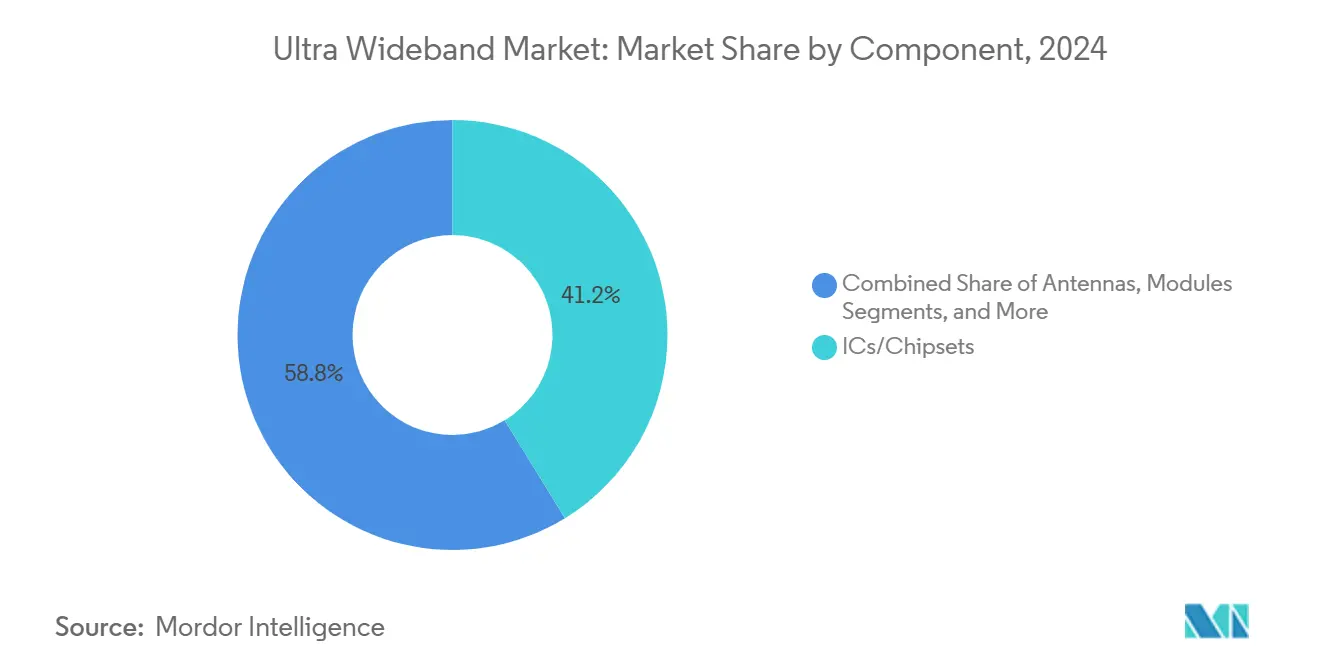
Note: Segment shares of all individual segments available upon report purchase
By End-user Vertical: Automotive Accelerates Digital Transformation
Consumer Electronics dominated with 36.45% of 2024 revenue, owing to flagship smartphones and wearables that showcase hands-free unlocking and spatial-audio features. Automotive and Transportation are on course for the fastest 23.02% CAGR as digital keys, child-presence detection, and in-cabin gesture control become mainstream. Tesla’s live deployment legitimized phone-as-key use cases, inspiring Hyundai, Volkswagen, and BMW to embed FiRa-certified transceivers starting with 2026 model launches. In hospitals, UWB tags cut equipment search time by 30%, confirming tangible ROI for healthcare buyers.
The vertically diversified order book shields suppliers from cyclical dips in any single sector. Retailers experiment with UWB drones for inventory scans, exemplified by Verity’s deployment at a 266,000 ft² UPS facility that slashed cycle-count labor by 80%. Defense agencies issue SBIR calls for GPS-denied navigation, seeding long-range R&D projects. Each vertical imposes distinct accuracy and certification hurdles, prompting vendors to spin tailored firmware builds and reference designs.
By Device Type: Smartphones Lead, Autonomous Systems Surge
Smartphones represented the largest 38.67% slice of 2024 shipments as UWB became a staple premium-tier feature. Meanwhile, Drones and Robots are predicted to post a 24.26% CAGR because logistics hubs and factories adopt autonomous vehicles to boost throughput. SPARK Microsystems’ SR1120 transceiver claims 40× the throughput of BLE while sipping similar power, making it ideal for aerial robots that demand high data volume and long flight time. Wearables continue integrating UWB to support precise indoor navigation and ultra-secure payments.
The Ultra Wideband market size for autonomous systems is expected to jump six-fold by 2030 as multi-sensor fusion couples UWB ranging with LiDAR and vision. In sports analytics, the NFL deploys over 250 UWB beacons per stadium to capture real-time athlete positioning, illustrating scalability in high-density scenarios. Cross-device interoperability standards from the FiRa Consortium smooth user experience by ensuring any certified tag talks to any certified phone.
By Frequency Band: Higher Bands Dominate Despite Lower Band Growth
The 6-10.6 GHz band accounted for 54.12% of 2024 revenue because greater bandwidth enables finer resolution. Yet the 3.1-4.8 GHz band is slated to grow at 21.68% CAGR as regulators align maximum power masks and as outdoor applications seek better wall penetration. Meta’s patent on in-band discovery frames signals to squeeze more ranging packets without breaching emission limits, indicating ongoing innovation.
Deployers mix multi-band anchors to balance range and accuracy in warehouses. Automotive radar designers prefer upper-band channels for cabin sensing, whereas miners rely on lower-band nodes to track vehicles in tunnels where attenuation spikes. Multi-band SoCs hitting the market by 2026 will let integrators toggle frequencies on the fly, satisfying regional spectrum policies and optimizing performance.
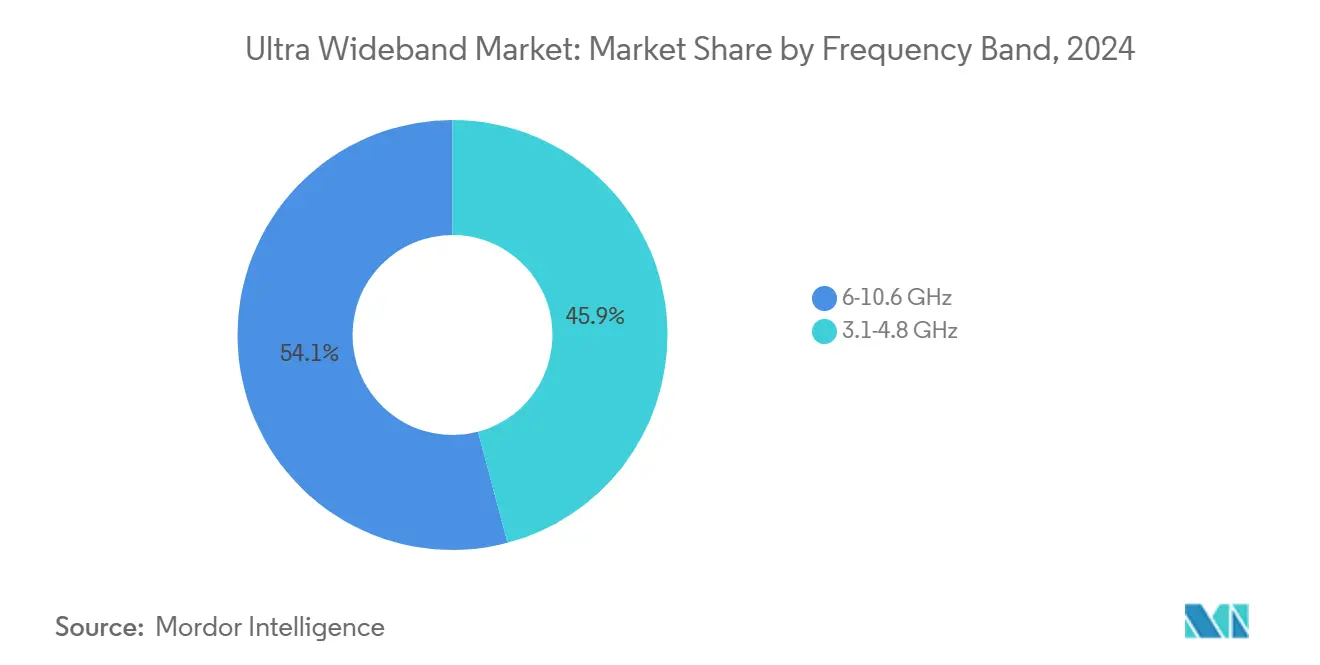
By Range Capability: Short-Range Applications Dominate Current Market
Short-range installations under 10 m captured 62.34% of 2024 spending, largely from smartphone peer-to-peer use, digital car keys, and retail checkouts. Long-range operations beyond 30 m, though niche today, are forecast for the swiftest 22.73% CAGR as precision-GNSS augmentation and defense tracking accelerate demand. The Ultra Wideband market size for long-range nodes is propelled by federated RTLS networks in shipyards and ports that need low-latency visibility across hundreds of meters.
Signal-processing breakthroughs such as coded pulse repetition and M-sequence modulation enhance resilience at extended distances without exceeding power masks. The US Navy’s SBIR calls underscore military interest in kilometer-scale UWB navigation for GPS-denied missions. Power-efficient antenna arrays allow drones to ping beacons every 100 ms while still achieving 30-minute flight endurance. As lower-band approvals mature in Latin America and Southeast Asia, outdoor safety tracking for miners and construction workers will multiply addressable volume.
Geography Analysis
North America controlled 42.10% of 2024 revenue, underpinned by early-stage enterprise pilots, robust semiconductor supply chains, and mature regulatory statutes. The Federal Communications Commission codified emission-limit clarity as early as 2002 and updated technical guidelines in 2024, giving integrators a predictable certification path. Silicon Valley start-ups tap deep venture funding to pursue AI-enhanced trilateration, while defense spending guarantees recurring orders for ruggedized nodes. Automotive majors such as Ford and General Motors run advanced driver assistance testbeds that rely on secure ranging to authenticate over-the-air software updates.
Asia Pacific is projected to post the fastest 21.61% CAGR through 2030, aided by smartphone OEM dominance, dense manufacturing corridors, and growing government backing. China’s MIIT formalized channel 9 requirements to curtail adjacent service interference, triggering domestic fabless houses to roll out compliant chips. Samsung’s in-house silicon stack and Korean supply ecosystem accelerate time-to-market for consumer electronics with a range of features. Chinese system integrators such as Woxu Wireless claim more than 12,000 industrial RTLS sites using UWB anchors, validating volume economics.
Europe delivered steady high-single-digit expansion after the European Communications Committee allowed a 10 dB indoor power bump in 2024. German carmakers adopt digital keys to differentiate premium models, while logistics giants deploy UWB drones for pallet audits in big-box warehouses. Governments in the Middle East and Latin America initiate pilot projects but lag in harmonized licensing practice, suppressing immediate scale. Nonetheless, technology diffusion through multinational tier-1 suppliers ensures eventual uplift in these regions as cost curves fall.
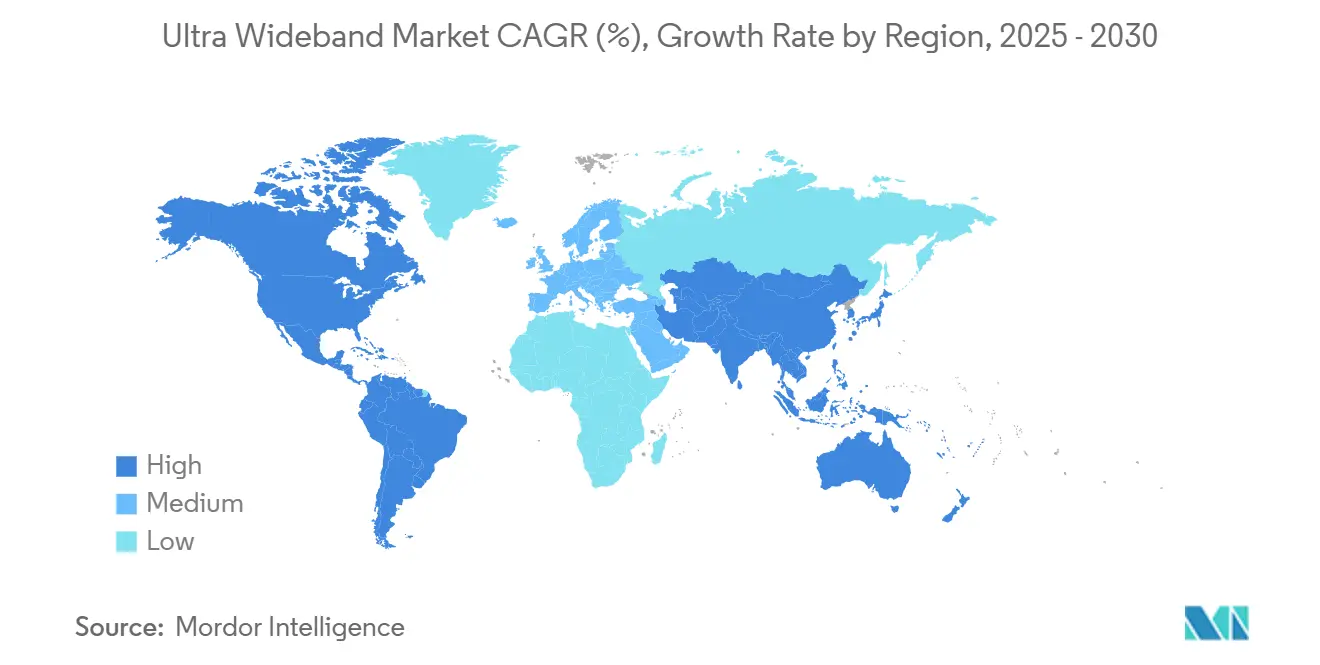
Competitive Landscape
The Ultra Wideband market features moderate concentration, with roughly a dozen silicon suppliers sharing the majority of revenue. Qorvo, NXP, Qualcomm, and Samsung exploit deep RF design expertise and front-end module portfolios to erect entry barriers around low-power amplifiers and beamforming engines. Zebra Technologies sustains leadership in fully integrated RTLS platforms, blending anchors, tags, and cloud analytics that make procurement frictionless for enterprise buyers.
Partnerships proliferate as chipmakers team with MCU vendors and cloud service providers to shorten design cycles. Qualcomm joined hands with STMicroelectronics in October 2024 to pair UWB connectivity with MEMS sensors, enabling context-aware location services for industrial IoT gateways. Start-ups pursue software-defined ranging stacks running on generic RF transceivers, threatening to commoditize hardware mid-decade. Patent portfolios emerge as a defensive moat: Meta’s directional-awareness filings target AR/VR headsets, while Apple pursues multi-device choreography methods.
White-space niches surface in harsh-environment devices requiring ultra-low power and wide temperature tolerances. Radar-UWB fusion for in-cabin sensing, long-range mining beacons, and ultra-secure mobile payments present avenues for differentiation. Competitive intensity remains healthy but manageable due to regional certification hurdles and the steep learning curve in 3-10 GHz antenna design.
Ultra Wideband Industry Leaders
-
Qorvo Inc.
-
NXP Semiconductors NV
-
Zebra Technologies Corp.
-
Texas Instruments Inc.
-
Samsung Electronics Co. Ltd.
- *Disclaimer: Major Players sorted in no particular order
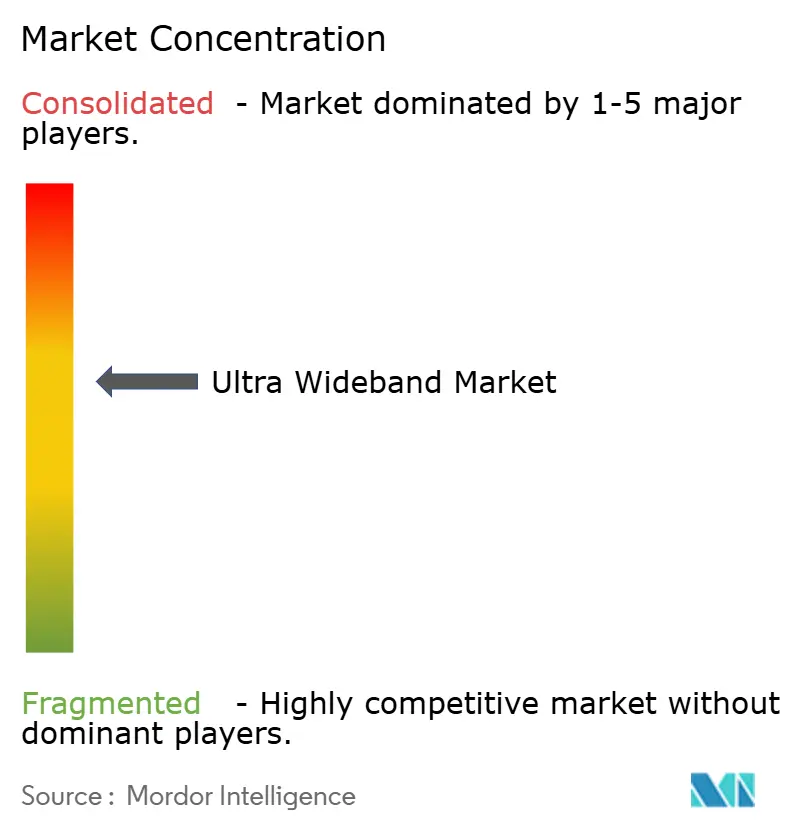
Recent Industry Developments
- March 2025: Qorvo launched the QM35825 fully integrated low-power UWB System-on-Chip targeting automotive and industrial designs.
- December 2024: Syntiant completed the USD 150 million acquisition of Knowles Consumer MEMS Microphones, enhancing edge-AI audio for UWB-enabled gadgets.
- November 2024: NXP Semiconductors unveiled the first UWB wireless battery-management system for electric-vehicle packs.
- October 2024: Qualcomm and STMicroelectronics formed a strategic collaboration to merge Qualcomm connectivity platforms with ST’s MEMS sensors for IoT devices.
- February 2024: Qualcomm introduced the FastConnect 7900 single-chip solution, integrating Wi-Fi 7, Bluetooth, and UWB for premium smartphones and connected cars.
Global Ultra Wideband Market Report Scope
Ultra-wideband (UWB) is a radio technology that covers a large part of the radio spectrum while sending short-range, high-bandwidth messages with very little power. As a short-range communication method, it works at very high frequencies, across a wide range of GHz frequencies, to collect accurate information about space and direction.UWB has various traditional applications, especially in non-cooperative radar imaging. Most of its current applications focus on gathering exact locations and tracking sensor data.
The ultra-wideband market is segmented by application (RTLS, imaging, and communication), end-user vertical (healthcare, automotive and transportation, manufacturing, consumer electronics, retail, and other end-user verticals), and geography (North America, Europe, Asia-Pacific, Latin America, and Middle East & Africa). The report offers the market size in value terms in USD for all the abovementioned segments.
| Hardware | ICs/Chipsets |
| Antennas | |
| Modules | |
| Software |
| Consumer Electronics |
| Automotive and Transportation |
| Healthcare |
| Manufacturing and Industrial |
| Retail and Warehousing |
| Defense and Public Safety |
| Smartphones |
| Wearables and Hearables |
| Vehicles |
| Drones and Robots |
| Fixed Infrastructure (Gateways, Beacons) |
| 3.1-4.8 GHz |
| 6-10.6 GHz |
| Short-Range (<10 m) |
| Mid-Range (10–30 m) |
| Long-Range (>30 m) |
| North America | United States |
| Canada | |
| Mexico | |
| South America | Brazil |
| Rest of South America | |
| Europe | Germany |
| France | |
| United Kingdom | |
| Italy | |
| Spain | |
| Russia | |
| Rest of Europe | |
| Asia Pacific | China |
| Japan | |
| South Korea | |
| India | |
| Australia and New Zealand | |
| Southeast Asia | |
| Rest of Asia Pacific | |
| Middle East | GCC |
| Turkey | |
| Rest of Middle East | |
| Africa | South Africa |
| Rest of Africa |
| By Component | Hardware | ICs/Chipsets |
| Antennas | ||
| Modules | ||
| Software | ||
| By End-user Vertical | Consumer Electronics | |
| Automotive and Transportation | ||
| Healthcare | ||
| Manufacturing and Industrial | ||
| Retail and Warehousing | ||
| Defense and Public Safety | ||
| By Device Type | Smartphones | |
| Wearables and Hearables | ||
| Vehicles | ||
| Drones and Robots | ||
| Fixed Infrastructure (Gateways, Beacons) | ||
| By Frequency Band | 3.1-4.8 GHz | |
| 6-10.6 GHz | ||
| By Range Capability | Short-Range (<10 m) | |
| Mid-Range (10–30 m) | ||
| Long-Range (>30 m) | ||
| By Geography | North America | United States |
| Canada | ||
| Mexico | ||
| South America | Brazil | |
| Rest of South America | ||
| Europe | Germany | |
| France | ||
| United Kingdom | ||
| Italy | ||
| Spain | ||
| Russia | ||
| Rest of Europe | ||
| Asia Pacific | China | |
| Japan | ||
| South Korea | ||
| India | ||
| Australia and New Zealand | ||
| Southeast Asia | ||
| Rest of Asia Pacific | ||
| Middle East | GCC | |
| Turkey | ||
| Rest of Middle East | ||
| Africa | South Africa | |
| Rest of Africa | ||
Key Questions Answered in the Report
How large is the Ultra Wideband market in 2025 and what growth is expected by 2030?
The Ultra Wideband market size is USD 1.28 billion in 2025 and is projected to reach USD 3.24 billion by 2030, reflecting a 20.41% CAGR.
Which region leads current Ultra Wideband adoption?
North America leads with 42.10% share in 2024, supported by early enterprise pilots, clear FCC rules, and a robust semiconductor ecosystem.
What is the fastest-growing end-user sector for UWB technology?
Automotive and Transportation shows the highest 23.02% CAGR through 2030, driven by digital keys and in-cabin sensing mandates.
Which component segment is expanding the quickest?
Software is the fastest-growing component, advancing at 22.15% CAGR as companies demand AI-enhanced location algorithms and analytics platforms.
Why is UWB preferred over Bluetooth AoA/AoD in industrial plants?
UWB maintains centimeter-level accuracy in multipath-heavy, metallic environments where BLE’s signal reflections reduce precision, ensuring reliable asset tracking.
What are the primary restraints on near-term UWB growth?
Cost-effective BLE Direction Finding for sub-meter needs and advanced-node chip supply constraints below 28 nm remain the main headwinds through 2027.
Page last updated on:
